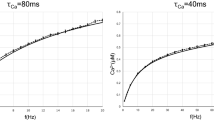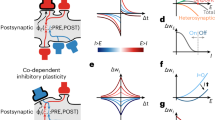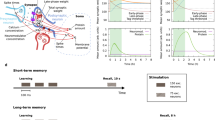Abstract
Use-dependent modifications, such as long-term potentiation (LTP) of synaptic efficacy, are believed to be essential for information storage in the nervous system. Repetitive correlated spiking of presynaptic and postsynaptic neurons can induce LTP at excitatory glutamatergic synapses. In cultured hippocampal neurons, we show that repetitive correlated activity also results in a rapid and persistent enhancement of presynaptic excitability, decreasing the threshold for spiking and reducing the variability of interspike intervals. Furthermore, we found that correlated activity modified sodium channel gating in the presynaptic neuron. This modification of presynaptic excitability required a temporal order between presynaptic and postsynaptic spiking and activation of postsynaptic NMDA receptors. Presynaptic inhibition of protein kinase C abolished the change in excitability without affecting LTP. Such rapid activity-dependent changes in the efficacy of presynaptic spiking may be involved in the processing and storage of information within the nervous system.
This is a preview of subscription content, access via your institution
Access options
Subscribe to this journal
Receive 12 print issues and online access
$209.00 per year
only $17.42 per issue
Buy this article
- Purchase on Springer Link
- Instant access to full article PDF
Prices may be subject to local taxes which are calculated during checkout








Similar content being viewed by others
References
Bliss, T. V. & Collingridge, G. L. A synaptic model of memory: long-term potentiation in the hippocampus. Nature 361, 31–39 (1993).
Katz, L. C. & Shatz, C. J. Synaptic activity and the construction of cortical circuits. Science 274, 1133–1138 (1996).
Marder, E., Abbott, L. F., Turrigiano, G. G., Liu, Z. & Golowasch, J. Memory from the dynamics of intrinsic membrane currents. Proc. Natl. Acad. Sci. USA 93, 13481–13486 (1996).
Malenka, R. C. & Nicoll, R. A. NMDA-receptor-dependent synaptic plasticity: multiple forms and mechanisms. Trends Neurosci. 16, 521–527 (1993).
Malenka, R. C. & Nicoll, R. A. Long-term potentiation–A decade of progress? Science 285, 1870–1874 (1999).
Markram, H., Leubke, J., Frotscher, M. & Sakmann, B. Regulation of synaptic efficacy by coincidence of postsynaptic APs and EPSPs. Science 275, 213–215 (1997).
Magee, J. C. & Johnston, D. A synaptically controlled, associative signal for Hebbian plasticity in hippocampal neurons. Science 275, 209–213 (1997).
Bell, C. C., Han, V. Z., Sugawara, Y. & Grant, K. Synaptic plasticity in a cerebellum-like structure depends on temporal order. Nature 387, 278–281 (1997).
Debanne, D., Gahwiler, B. H. & Thompson, S. M. Long-term synaptic plasticity between pairs of individual CA3 pyramidal cells in rat hippocampal slice cultures. J. Physiol. (Lond.) 507, 237–247 (1998).
Zhang, L. I., Tao, H. W., Holt, C. E., Harris, W. A. & Poo, M.-M. A critical window for cooperation and competition among developing retinotectal synapses. Nature 395, 37–44 (1998).
Bi, G. Q. & Poo, M.-M. Synaptic modifications in cultured hippocampal neurons: dependence on spike timing, synaptic strength, and postsynaptic cell type. J. Neurosci. 18, 10464–10472 (1998).
Turrigiano, G., Abbott, L. F. & Marder, E. Activity-dependent changes in the intrinsic properties of cultured neurons. Science 264, 974–977 (1994).
Desai, N. S., Rutherford, L. C. & Turrigiano, G. G. Plasticity in the intrinsic excitability of cortical pyramidal neurons. Nat. Neurosci. 2, 515–520 (1999).
Nick, T. A. & Ribera, A. B. Synaptic activity modulates presynaptic excitability. Nat. Neurosci. 3, 142–149 (2000).
Aizenman, C. D. & Linden, D. J. Rapid, synaptically driven increases in the intrinsic excitability of cerebellar deep nuclear neurons. Nat. Neurosci. 3, 109–111 (2000).
Armano, S., Rossi, P., Taglietti, V. & D'Angelo, E. Long-term potentiation of intrinsic excitability at the mossy fiber-granule cell synapse of rat cerebellum. J. Neurosci. 20, 5208–5216 (2000).
Bliss, T. V. & Lømo, T. Long-lasting potentiation of synaptic transmission in the dentate area of the anaesthetized rabbit following stimulation of the perforant path. J. Physiol. (Lond.) 232, 331–356 (1973).
Bliss, T. V. & Gardner-Medwin, A. R. Long-lasting potentiation of synaptic transmission in the dentate area of the unanaesthetized rabbit following stimulation of the perforant path. J. Physiol. (Lond.) 232, 357–374 (1973).
Taube, J. S. & Schwartzkroin, P. A. Mechanisms of long-term potentiation: EPSP/spike dissociation, intradendritic recordings, and glutamate sensitivity. J. Neurosci. 8, 1632–1644 (1988).
McNaughton, B. L., Shen, J., Rao, G., Foster, T. C. & Barnes, C. A. Persistent increase of hippocampal presynaptic axon excitability after repetitive electrical stimulation: dependence on N-methyl-D-aspartate receptor activity, nitric-oxide synthase, and temperature. Proc. Natl. Acad. Sci. USA 91 4830–4834 (1994).
Abraham, W. C., Gustafsson, B. & Wigström, H. Long-term potentiation involves enhanced synaptic excitation relative to synaptic inhibition in guinea-pig hippocampus. J. Physiol. (Lond.) 394, 367–380 (1987).
Abraham, W. C., Bliss, T. V. & Goddard, G. V. Heterosynaptic changes accompany long-term but not short-term potentiation of the perforant path in the anaesthetized rat. J. Physiol. (Lond.) 363, 335–349 (1985).
Chavez-Noriega, L. E., Halliwell, J. V. & Bliss, T. V. A decrease in firing threshold observed after induction of the EPSP-spike (E-S) component of long-term potentiation in rat hippocampal slices. Exp. Brain Res. 79, 633–641 (1990).
Lu, Y. M., Mansuy, I. M., Kandel, E. R. & Roder, J. Calcineurin-mediated LTD of GABAergic inhibition underlies the increased excitability of CA1 neurons associated with LTP. Neuron 26, 197–205 (2000).
McBain, C. J., Freund, T. F. & Mody, I. Glutamatergic synapses into hippocampal interneurons: precision timing without lasting plasticity. Trends Neurosci. 22, 228–235 (1999).
Sik, A., Hajos, N., Gulacsi, A., Mody, I. & Freund, T. F. The absence of a major Ca2+ signaling pathway in GABAergic neurons of the hippocampus. Proc. Natl. Acad. Sci.USA 95, 3245–3250 (1998).
Hu, G. Y. et al. Protein kinase C injection into hippocampal pyramidal cells elicits features of long-term potentiation. Nature 328, 426–429 (1987).
Malinow, R., Schulman, H. & Tsien, R. W. Inhibition of postsynaptic PKC or CaMKII blocks induction but not expression of LTP. Science 245, 862–866 (1989).
West, J. W., Numann, R., Murphy, B. J., Scheuer, T. & Catterall, W. A. A phosphorylation site in the Na+ channel required for modulation by protein kinase C. Science 254, 866–868 (1991).
Hopfield, J. J. Pattern recognition computation using action potential timing for stimulus representation. Nature 376, 33–36 (1995).
Mainen, Z. F. & Sejnowski, T. J. Reliability of spike timing in neocortical neurons. Science 268, 1503–1506 (1995).
Schneidman, E., Freedman, B. & Segev, I. Ion channel stochasticity may be critical in determining the reliability and precision of spike timing. Neural Comput. 10, 1679–1703 (1998).
Stevens, C. F. & Zador, A. M. Input synchrony and the irregular firing of cortical neurons. Nat. Neurosci. 1, 210–207 (1998).
Diesmann, M., Gewaltig, M.-O. & Aertsen, A. Stable propagation of synchronous spiking in cortical neural networks. Nature 402, 529–533 (1999).
Lisman, J. E. Bursts as a unit of neural information: making unreliable synapses reliable. Trends Neurosci. 20, 38–43 (1997).
Stuart, G. J. & Sakmann, B. Active propagation of somatic action potentials into neocortical pyramidal cell dendrites. Nature 367, 69–72 (1994).
Zamanillo, D. et al. Importance of AMPA receptors for hippocampal synaptic plasticity but not for spatial learning. Science 284, 1805–1811 (1999).
Moyer, J. R. Jr., Thompson, L. T. & Disterhoft, J. F. Trace eyeblink conditioning increases CA1 excitability in a transient and learning-specific manner. J. Neurosci. 16, 5536–5546 (1996).
Rae, J., Cooper, K., Gates, P. & Watsky, M. Low access resistance perforated patch recordings using amphotericin B. J. Neurosci. Methods 37, 15–26 (1991).
Acknowledgements
We thank B. Berninger, A.F. Schinder, G.-q. Bi, F. Engert and S. Andersen for discussion and comments on the manuscript, and X.-y. Wang for the preparation of cell cultures. This work was supported by a grant from NIH.
Author information
Authors and Affiliations
Corresponding author
Rights and permissions
About this article
Cite this article
Ganguly, K., Kiss, L. & Poo, Mm. Enhancement of presynaptic neuronal excitability by correlated presynaptic and postsynaptic spiking. Nat Neurosci 3, 1018–1026 (2000). https://doi.org/10.1038/79838
Received:
Accepted:
Issue Date:
DOI: https://doi.org/10.1038/79838
This article is cited by
-
Single-neuron mechanical perturbation evokes calcium plateaus that excite and modulate the network
Scientific Reports (2023)
-
The plasticitome of cortical interneurons
Nature Reviews Neuroscience (2023)
-
Input-dependent subcellular localization of spike initiation between soma and axon at cortical pyramidal neurons
Molecular Brain (2014)
-
Tracking axonal action potential propagation on a high-density microelectrode array across hundreds of sites
Nature Communications (2013)
-
Progress in neural plasticity
Science China Life Sciences (2010)



